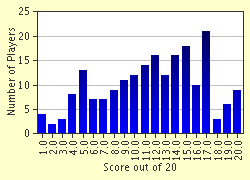Quiz Answer Key and Fun Facts
1. How much did Christie eventually make from this novel?
2. What key word is consistently misspelled in the original edition of the book?
3. The book is narrated by Captain Hastings, a friend of John Cavendish. What does he tell Mary Cavendish (John's wife) he has a secret hankering to be?
4. Which of the following is true of Mary Cavendish?
5. Two people are observed to shed tears for the murdered Emily Inglethorpe. Who are they?
6. What two things are of primary significance to Poirot about the day of the murder?
7. Poirot finds a crumpled piece of paper in the wastebasket of Emily's boudoir, on which is written "Posessed/I am posessed/he is possessed/I am possessed/ possessed" What single thing about this is significant to him?
8. Why is Poirot determined that Alfred Inglethorpe shall not be arrested for the murder?
9. When Cynthia Murdoch confides to Hastings her concern for her uncertain future after Emily's death, what does Hastings do?
10. Why did Lawrence crush the cup on the floor of the dead woman's room almost to powder?
11. Whom does Evelyn Howard attempt to implicate in the murder?
12. What strikes Hastings as notable about Evelyn Howard's behavior, though he does not realize its true significance?
13. Which of the following is true of Evelyn Howard and Alfred Inglethorp's relationship?
14. This novel introduces both Poirot and Hastings. Which other fixture of the Poirot mysteries is introduced here?
15. Who impersonated Alfred Inglethorpe at the druggists?
16. The mysterious Dr. Bauerstein, although he does not turn out to be the murderer, nonetheless does turn out to be a criminal. What is his crime?
17. What causes Poirot to realize that the incriminating letter written by Alfred to Evelyn was in the spill vases on the mantelpiece?
18. In addition to the strychnine, Emily Inglethorpe (along with Cynthia) was given a mild narcotic to induce deep sleep on the night of her death. Who drugged Emily and Cynthia?
19. Christie's knowledge of poisons would never be put to better use than in this, her first mystery. How was Emily Inglethorpe poisoned?
20. Why did Poirot want John Cavendish to go on trial for the murder of Emily Inglethorpe?
Source: Author
jouen58
This quiz was reviewed by FunTrivia editor
bullymom before going online.
Any errors found in FunTrivia content are routinely corrected through our feedback system.

